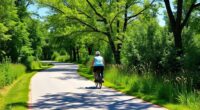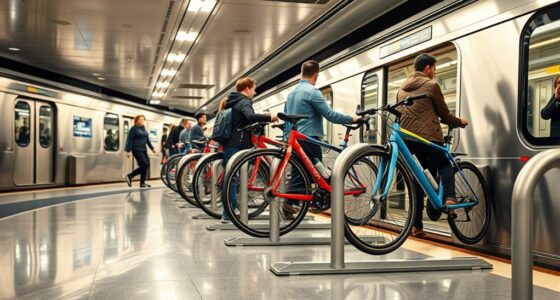To advocate for better bike lanes in your town, start by researching local traffic data and community needs. Gather support from advocacy groups and organize meetings to discuss safety benefits. Prepare for opposition by presenting data that shows bike lanes improve traffic flow. Engage with decision-makers by sharing success stories from other cities. Foster long-term community support through regular discussions and outreach. There’s a lot more effective strategies to explore that can enhance your advocacy efforts.
Key Takeaways
- Gather local traffic accident data and research to present a strong case for the need for better bike lanes.
- Build coalitions with local advocacy groups to increase support and leverage their expertise in promoting bike lanes.
- Organize community meetings to engage residents, gather input, and foster collaboration on bike lane initiatives.
- Propose temporary bike lane solutions to test designs and gather community feedback before implementing permanent changes.
- Explore various funding opportunities, including grants and community crowdfunding, to support the development of bike lanes.
Do Your Homework
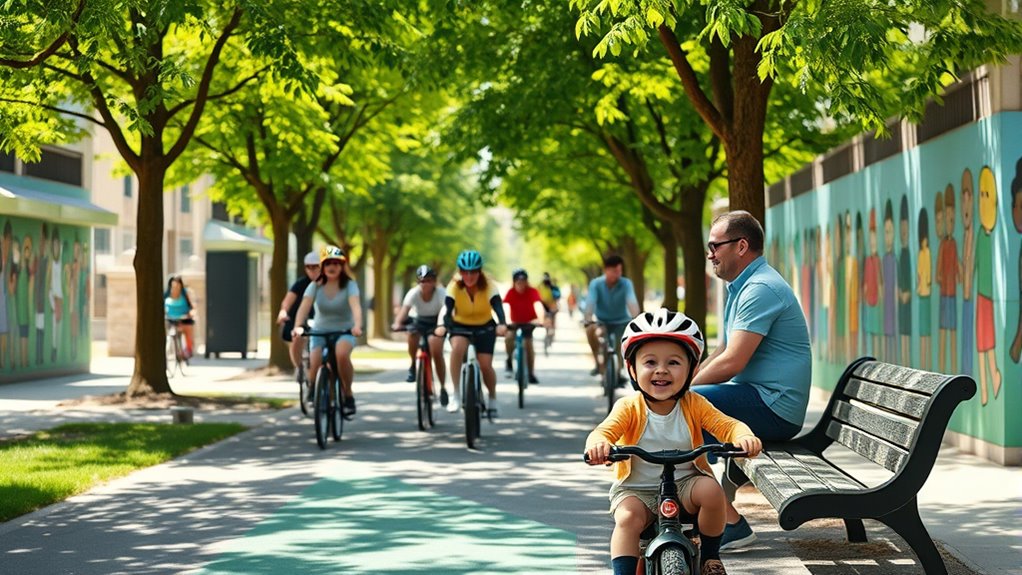
Before you start advocating for better bike lanes, it’s essential to do your homework.
First, explore local police records to uncover the history of accidents involving cyclists and pedestrians in your area. Identify those high-risk locations that would benefit from an improved bike network.
Explore local police records to identify high-risk areas for cyclists and pedestrians that could benefit from improved bike lanes.
Next, check if the streets you’re targeting are scheduled for repaving or reconstruction; this is a golden opportunity to push for bike lane integration.
Familiarize yourself with your city’s bicycle masterplan to see where proposed bike lanes align with the overall vision.
Finally, gather both anecdotal evidence and hard data that highlight the benefits of bike lanes, such as reduced traffic accidents, to bolster your advocacy efforts effectively. Incorporating comprehensive evaluations of existing transportation safety can provide a clearer picture of the need for improved infrastructure.
Get Community and City Buy In

To gain community and city support for better bike lanes, you need to engage local stakeholders actively.
Start by building coalitions with bike advocacy groups and organizing community meetings to gather input and foster collaboration. Additionally, ensure to set specific savings goals for funding initiatives that can help improve cycling infrastructure in your town.
Engage Local Stakeholders
Engaging local stakeholders is essential for garnering support for bike lane initiatives, as communities with active participation are more likely to see successful changes.
To effectively engage local stakeholders, consider the following steps:
- Research Local Crash Data: Present compelling evidence to city officials about the need for safer bike lanes.
- Collaborate with Bike Advocacy Groups: Leverage their established relationships and mobilize community support through events.
- Involve Schools and Youth Organizations: Educate younger generations on the benefits of cycling to build lasting advocacy.
- Gather Community Feedback: Use surveys or public forums to let residents voice their concerns, making them feel invested in the planning process. Additionally, fostering a sense of community support can enhance the likelihood of successful initiatives.
Build Supportive Coalitions
Building supportive coalitions is vital for ensuring your bike lane initiatives gain traction within the community and city government.
Engage with local bike advocacy groups; they can amplify your efforts and provide valuable resources. Foster relationships with city counselors and officials, as their backing can greatly influence project approval and funding.
Involve families, elderly residents, and community members in discussions about safer streets to create a wider support base, demonstrating that better bike lanes are better for people of all demographics.
Collect community input through surveys or public meetings to address concerns and preferences.
Finally, present a concise, fact-based case that includes safety data and anecdotal evidence to persuade officials to prioritize cycling infrastructure improvements. Additionally, consider organizing community events that promote local bike advocacy groups to further strengthen your coalition and engage more residents.
Engage With Local Advocacy Groups
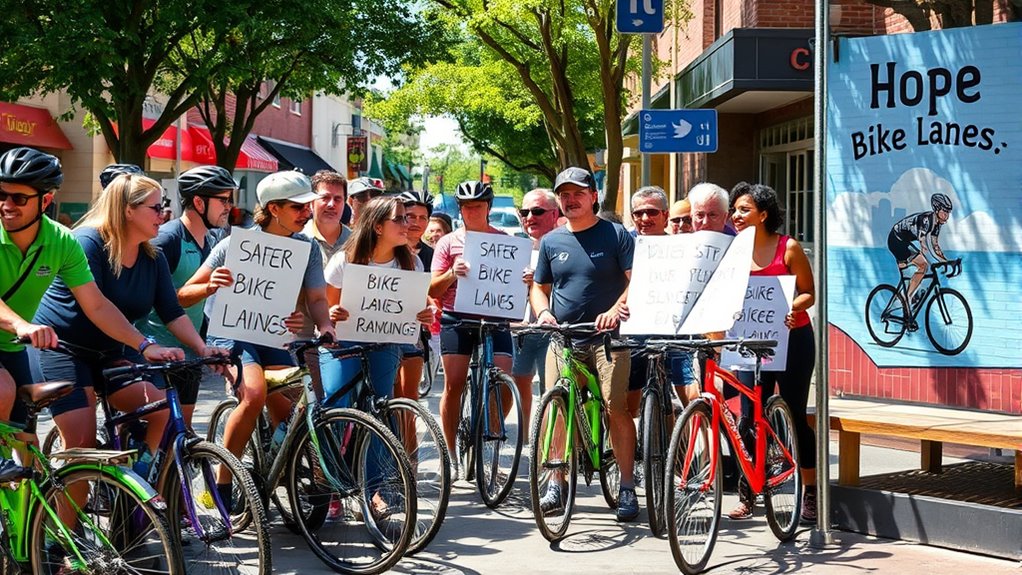
Here are some ways to engage:
- Leverage Expertise: Tap into their knowledge of successful strategies and best practices.
- Build Relationships: Collaborate with advocacy groups to gain access to their connections with city officials, improving your chances of gaining support.
- Utilize Data: Benefit from their community surveys and data on cycling patterns to bolster your case for better infrastructure.
- Enhance Outreach: Join forces to organize events that raise awareness about the benefits of cycling and bike lane safety.
- Incorporate Personal Touches: Engage community members by sharing stories and experiences that highlight the importance of bike lane safety in promoting a healthier lifestyle.
Working together with local advocacy groups can make your efforts more impactful.
Prepare for Opposition

You’ll likely face concerns from drivers worried about parking and traffic flow when advocating for bike lanes. Be ready to present solid counterarguments and data that show how bike lanes can actually enhance safety and efficiency. Engaging respectfully with skeptics can help turn opposition into support, so prepare to listen and respond thoughtfully. Additionally, studies have shown that high contrast ratios in urban environments can improve visibility for both cyclists and drivers, further promoting safety on the roads.
Anticipate Common Concerns
As you advocate for better bike lanes, it’s crucial to anticipate the common concerns that may arise, particularly from drivers worried about losing parking spaces.
Here are some key points to reflect on:
- Traffic Flow: Present data showing that bike lanes can enhance overall traffic flow and safety.
- Safety Statistics: Share research indicating that bike lanes reduce accidents and fatalities for cyclists and pedestrians.
- Congestion Myths: Address misconceptions by highlighting studies showing minimal impact on vehicle travel times with bike lanes.
- Successful Examples: Cite cities where bike lanes were added without disrupting traffic patterns, demonstrating the feasibility of your proposal.
Engaging with community members will help you address specific concerns and strengthen your case for better biking infrastructure. Additionally, consider how timely storytelling about successful bike lane implementations can resonate with the public and bolster your advocacy efforts.
Present Counterarguments Effectively
When presenting counterarguments, it’s essential to address the concerns of those who might oppose better bike lanes with clear, data-backed responses. Here’s a simple breakdown of key points:
| Concern | Data-Backed Response | Impact |
|---|---|---|
| Traffic Delays | Improved flow reduces delays by 10-20% | Less congestion |
| Cyclist Safety | Protected lanes reduce injuries by up to 90% | Safer biking environment |
| Parking Space | Increased business revenue by 20% in Portland | Economic boost |
| Vehicle Accidents | Bike lanes lead to fewer accidents with cyclists | Enhanced driver safety |
| Biking Frequency | 30% increase in cycling leads to better public health | Healthier community |
Use these responses to build your case and reassure skeptics about the benefits of biking infrastructure. Moreover, implementing data-driven decision-making can help advocate for these changes more effectively by showcasing the tangible benefits of improved biking infrastructure.
Engage Respectfully With Detractors
Engaging respectfully with detractors is essential for fostering understanding and collaboration in the push for better bike lanes. Here are some strategies to approach the conversation:
- Gather Data: Show how bike lanes can enhance traffic flow and safety for all users.
- Address Concerns: Present evidence of decreased accidents in areas with protected bike infrastructure.
- Invite Dialogue: Encourage participation in community discussions, allowing you to listen and clarify misconceptions.
- Highlight Safety Issues: Use local crash data to illustrate the need for bike lanes and their potential to protect vulnerable road users.
Recognize that changing minds takes time. Additionally, promoting safety can draw parallels to how grapes are toxic for dogs, emphasizing the importance of informed community choices.
Focus on building relationships and maintaining ongoing dialogue to cultivate a supportive community for bike lane initiatives.
Present a Strong Case to Decision-Makers
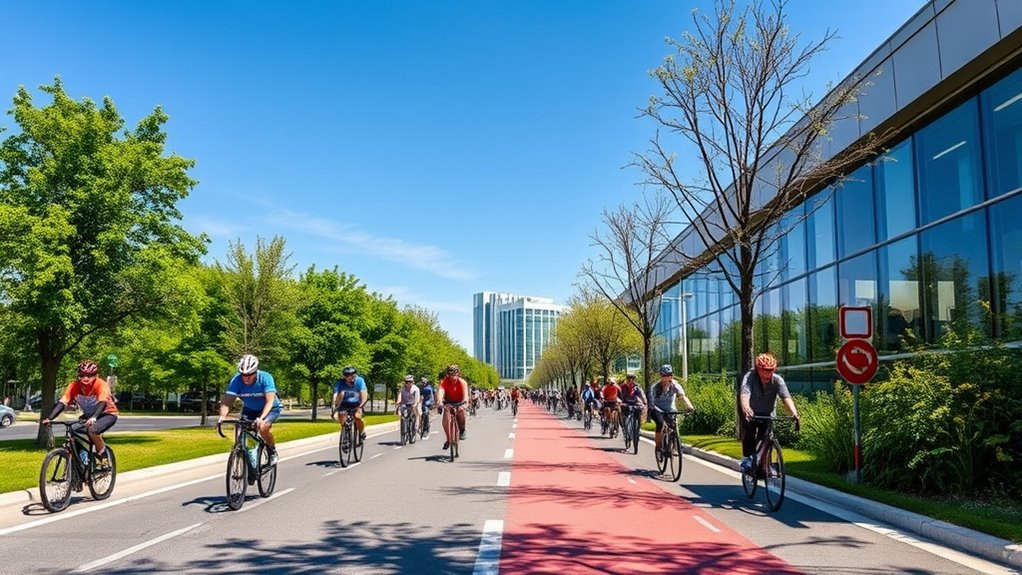
To effectively persuade decision-makers, you need to present a compelling case that highlights the urgent need for dedicated bike lanes in your community.
Start by collecting hard data on local traffic accidents involving cyclists and pedestrians, showing how protected bike lanes can reduce these incidents.
Collect data on local cyclist and pedestrian accidents to demonstrate how protected bike lanes can significantly reduce these incidents.
Emphasize benefits like increased cycling frequency, improved community health, and reduced air pollution.
Reference successful case studies from other cities that implemented bike lanes, illustrating increased cycling activity and community satisfaction.
Engage with local advocacy groups to gather testimonials that reflect the demand for safer biking infrastructure.
Finally, counter common objections by using statistics that demonstrate how bike lanes can enhance overall traffic flow and accessibility for everyone. Additionally, highlight how investing in safer bike lanes can lead to increased community health, similar to the benefits seen in cities that prioritize cycling infrastructure.
Design for Safety and Usability

When it comes to designing safer bike lanes, protective infrastructure is key.
You’ll find that an iterative implementation approach allows for adjustments based on real-world feedback, ensuring the lanes truly meet your needs.
Plus, involving the community in the design process can lead to a more user-friendly and widely accepted cycling environment.
Protective Infrastructure Design
While traditional bike lanes often leave cyclists vulnerable to traffic, protective infrastructure design prioritizes their safety and usability. Implementing features that create a safer environment can drastically reduce accidents and injuries.
Here are four key components:
- Physically separated bike lanes: These can reduce cyclist injuries by up to 90% compared to painted lanes.
- Curb-protected lanes or bollards: They create a buffer between cyclists and vehicles, enhancing safety.
- Clear signage and reflective materials: These improve visibility and awareness for both cyclists and drivers, especially in low-light conditions.
- Bike boxes at intersections: They allow cyclists to position themselves ahead of vehicles, reducing the risk of right-hook collisions.
Advocating for these designs can lead to safer, more usable bike lanes in your town.
Iterative Implementation Approach
Building on the need for protective infrastructure, an iterative implementation approach offers a practical way to enhance bike lane safety and usability.
By using temporary installations, you can test bike lane designs and gather community feedback, making adjustments as needed. Cities like San Francisco have successfully implemented pilot programs, allowing modifications based on real-world usage before finalizing their bike lanes.
This method often leads to significant increases in cycling rates—some areas report up to a 200% rise after initial installations. Incorporating features like flexible barriers and adjustable road markings guarantees safety and comfort, while community engagement through workshops can highlight specific concerns, resulting in more effective and accessible bike lanes for everyone.
Community Involvement Opportunities
How can community involvement transform bike lane design into a safer and more user-friendly experience? By engaging local residents, you can guarantee the infrastructure meets everyone’s needs.
Here are some community involvement opportunities that can enhance bike lane usability:
- Host Workshops: Encourage collaboration on designs and gather feedback from diverse demographics, including families and the elderly.
- Collect Anecdotes: Gather stories from frequent cyclists to pinpoint existing challenges and improve safety.
- Temporary Installations: Set up pop-up bike lanes to test designs, allowing the community to provide feedback before permanent changes.
- Inclusive Discussions: Facilitate conversations that consider the needs of all users, making cycling more accessible for everyone.
With these strategies, you can create bike lanes that truly serve your community.
Implement Temporary Solutions
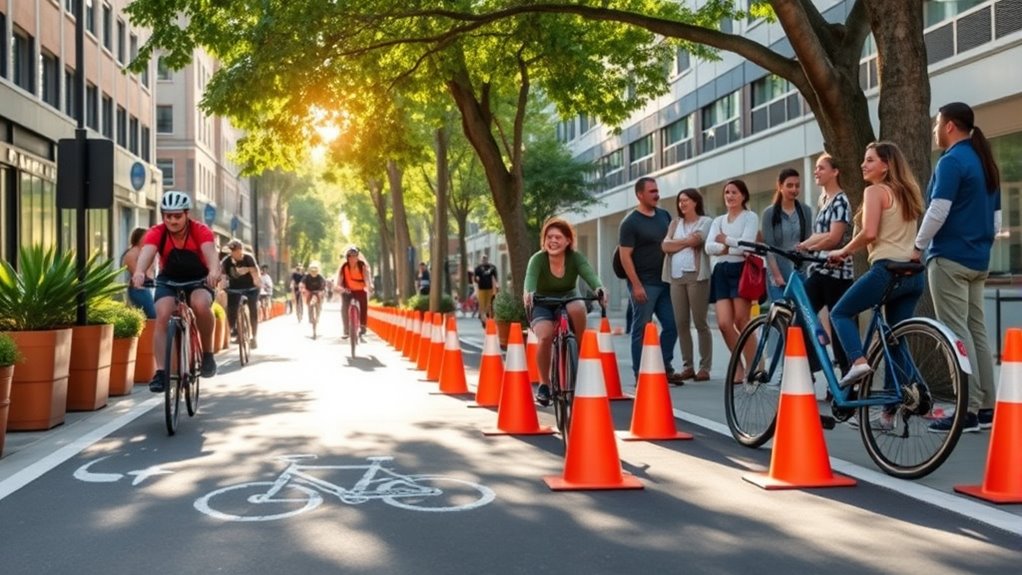
Implementing temporary bike lanes can greatly enhance urban cycling infrastructure by allowing cities to test designs before making permanent changes. Pop-up bike lanes, created with paint and flexible bollards, offer a practical way to gather community feedback and improve safety. Research shows these installations can reduce accidents by up to 40%, proving their effectiveness.
| Benefits | Strategies | Community Involvement |
|---|---|---|
| Enhanced safety | Host pop-up bike lanes | Engage local businesses |
| Increased usage | Use low-cost materials | Promote bike-friendly culture |
| Real-world testing | Gather feedback | Foster community investment |
Foster Long-Term Community Engagement
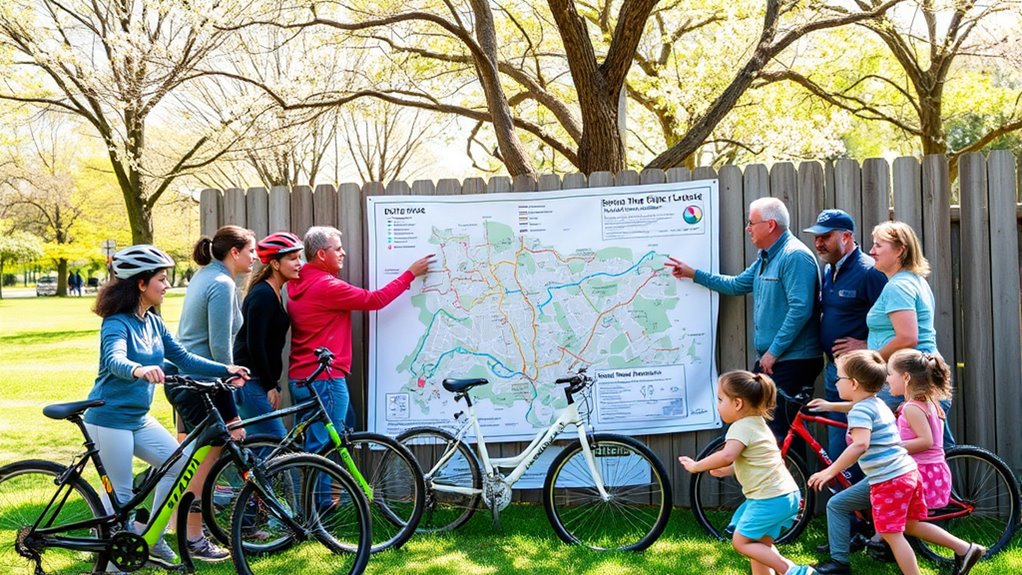
After testing temporary bike lanes, it’s important to keep the momentum going by fostering long-term community engagement. This guarantees that residents remain involved and invested in biking infrastructure.
Here are some effective ways to encourage community involvement:
- Initiate regular community meetings to discuss biking infrastructure, allowing residents to share experiences and suggestions.
- Create volunteer opportunities for local residents to participate in bike path clean-up and maintenance, strengthening community ties.
- Host educational events with schools and youth organizations to engage younger demographics in biking advocacy.
- Collaborate with local bike-advocacy groups to organize pop-up bike lanes during events, demonstrating potential improvements and gathering real-time feedback.
Measure and Report Success
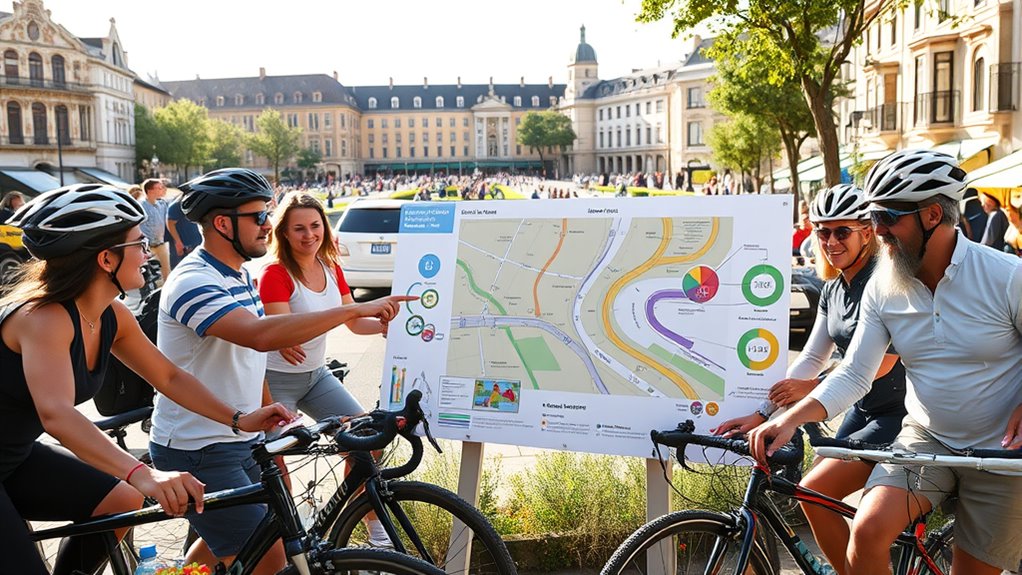
Measuring and reporting the success of bike lanes is essential for ongoing advocacy and improvements. Start by tracking accident rates before and after bike lane implementation to assess the impact on cyclist safety.
Gather feedback from cyclists through surveys or focus groups to identify areas needing improvement. You should also monitor changes in cycling frequency by counting cyclists using the lanes regularly.
Assess community satisfaction by holding public forums and surveys, focusing on residents’ perceptions of safety and accessibility.
Finally, compile and report your findings to stakeholders, including local government officials and community organizations. This data not only demonstrates the positive effects of bike lanes but also strengthens your case for future enhancements, especially if you’re advocating for a bike share system.
Explore Funding Opportunities
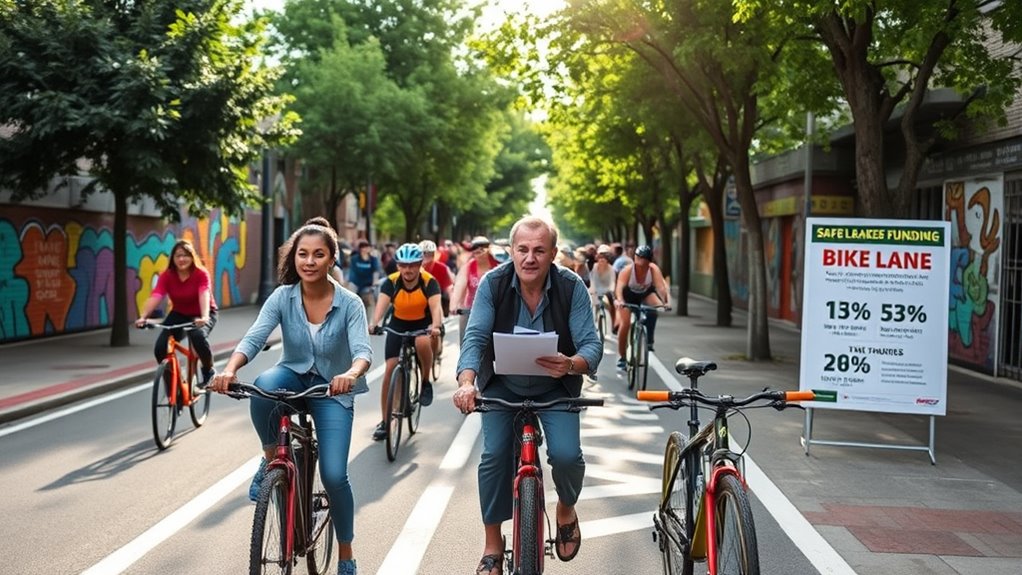
As you advocate for improved bike lanes, exploring funding opportunities becomes essential to turning your vision into reality.
Here are some effective ways to secure financial support for biking to your community:
Explore various funding avenues to enhance bike lanes in your community, from grants to local partnerships and crowdfunding.
- Research Grants: Look into local, state, and federal grants like the Transportation Alternatives Program (TAP) that fund cycling infrastructure projects.
- Partner with Businesses: Collaborate with local businesses for sponsorship, which can greatly reduce project costs through financial support or in-kind donations.
- Crowdfunding: Utilize platforms like GoFundMe to gather community contributions, allowing residents to invest in bike lane improvements directly.
- Engage Advocacy Groups: Connect with local cycling advocacy organizations that often have access to funding and resources for bike lane initiatives.
Frequently Asked Questions
How to Get Bike Lanes in Your Town?
To get bike lanes in your town, start by researching existing infrastructure and accident data to highlight the need.
Engage your community by hosting events to educate residents about the benefits of bike lanes.
Collaborate with local officials and advocacy groups to create a solid proposal.
Use social media to gather public support and explore funding options from grants and local businesses.
With determination and teamwork, you can make bike lanes a reality!
How to Improve Cycling Lanes?
Imagine riding on a smooth, colorful ribbon that weaves through your town.
To improve cycling lanes, you can push for separated lanes using paint and simple barriers for safety.
Consider proposing pop-up lanes to test community reactions before making permanent changes.
Encourage better crossings with painted islands and crosswalks.
Finally, rally local volunteers for maintenance and partner with businesses to create bike-sharing programs, making cycling a convenient and enjoyable option for everyone.
How Can I Make My Bike Lane Safer?
To make your bike lane safer, you can start by suggesting the installation of separated lanes using paint and bollards.
Advocate for clear signage and reflective paint to enhance visibility, especially at night.
Encourage local authorities to implement traffic calming measures, like speed bumps, to slow down vehicles.
Participating in community meetings can also help you voice concerns and propose improvements, fostering a safer environment for all cyclists in your area.
How to Make Cities Safer for Cyclists?
If you think riding a bike in the city is akin to a death-defying stunt show, you’re not alone!
To make cities safer for cyclists, push for two-way protected bike lanes, because who doesn’t love a good safety net?
Demand clear signage at intersections—navigating like a ninja isn’t everyone’s strength!
And let’s lower those speed limits; it’s not a race, folks!
Together, we can transform your urban jungle into a cyclist’s paradise.
Conclusion
By advocating for better bike lanes in your town, you’re not just improving safety; you’re fostering a healthier community and reducing traffic congestion. While some might argue that bike lanes decrease road space for cars, studies show they can actually enhance overall traffic flow. When you engage with your neighbors and local officials, you’re building a coalition for change. Remember, every pedal counts—your efforts can lead to safer, more vibrant streets for everyone. Keep pushing for progress!

